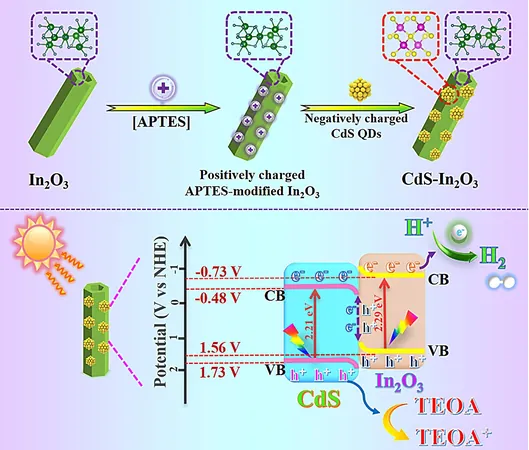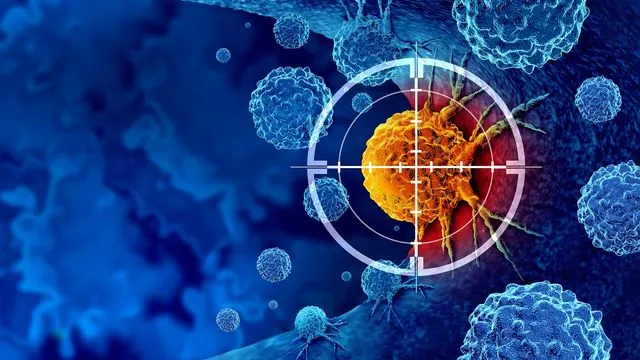
Revolutionizing Hydrogen Production: The Breakthrough S-Scheme Heterojunction
2025-04-30
Author: Liam
Unlocking Clean Energy with Photocatalysis
In the quest for sustainable energy solutions, photocatalytic hydrogen production is emerging as a game-changer. This innovative technology not only tackles the energy crisis but also addresses environmental pollution head-on. Among the frontrunners in this field is cadmium sulfide (CdS), a material celebrated for its optimal bandgap and adaptable surface structure.
The Power and Pitfalls of CdS
CdS quantum dots (QDs) are particularly noteworthy due to their quantum size effect, which enhances photocatalytic efficiency and allows for greater visible-light absorption. However, there’s a catch: CdS is plagued by high rates of photogenerated carrier recombination and is vulnerable to photocorrosion, severely limiting its effectiveness in practical applications.
Innovative Solutions to Overcome Challenges
To unlock the full potential of CdS, researchers have proposed various strategies, including morphology regulation, elemental doping, and the construction of advanced heterostructures. Among these, the development of S-scheme heterojunctions with suitable semiconductor partners stands out as a particularly promising approach.
The Game-Changing S-Scheme Heterojunction
The S-scheme heterojunction framework promotes distinct oxidation and reduction reactions at separate locations, effectively enhancing the spatial separation of photogenerated charges. This clever design allows scientists to significantly boost the photocatalytic activity of CdS.
A Groundbreaking Research Achievement
Recently, a research team led by Associate Professor Kang-Qiang Lu from Jiangxi University of Science and Technology achieved a remarkable breakthrough by creating an S-scheme heterojunction using CdS QDs paired with In2O3 hollow nanotubes. The results speak for themselves: this innovative design greatly enhances photocatalytic hydrogen production.
How It Works
This groundbreaking S-scheme heterojunction effectively inhibits the recombination of photogenerated carriers, promoting better electron separation and transfer. This advancement translates into not only improved photocatalytic hydrogen production rates but also increased stability of the composite material.
An Ingenious Fabrication Method
The S-scheme heterojunction was expertly crafted using a technique that involved electrostatic self-assembly, where CdS QDs are grown on the surfaces of In2O3 nanotubes. This hollow nanotube structure significantly enhances the composite’s specific surface area and creates abundant sites for hydrogen generation.
Proven Success and Future Implications
Through cutting-edge in-situ X-ray photoelectron spectroscopy (XPS) and density functional theory (DFT) analyses, the team validated the S-scheme mechanism of the CdS-In2O3 composites. Their comprehensive studies confirmed that this innovative heterostructure not only enhances the separation and migration of photogenerated carriers but also substantially improves the photocatalytic performance.
A Bright Future for Photocatalytic Hydrogen Production
As the world increasingly seeks clean and renewable energy solutions, the advancements in S-scheme heterojunction technology offer a promising glimpse into the future of hydrogen production. This breakthrough could pave the way for more efficient and sustainable methods of harnessing hydrogen as a clean energy source.









 Brasil (PT)
Brasil (PT)
 Canada (EN)
Canada (EN)
 Chile (ES)
Chile (ES)
 Česko (CS)
Česko (CS)
 대한민국 (KO)
대한민국 (KO)
 España (ES)
España (ES)
 France (FR)
France (FR)
 Hong Kong (EN)
Hong Kong (EN)
 Italia (IT)
Italia (IT)
 日本 (JA)
日本 (JA)
 Magyarország (HU)
Magyarország (HU)
 Norge (NO)
Norge (NO)
 Polska (PL)
Polska (PL)
 Schweiz (DE)
Schweiz (DE)
 Singapore (EN)
Singapore (EN)
 Sverige (SV)
Sverige (SV)
 Suomi (FI)
Suomi (FI)
 Türkiye (TR)
Türkiye (TR)
 الإمارات العربية المتحدة (AR)
الإمارات العربية المتحدة (AR)